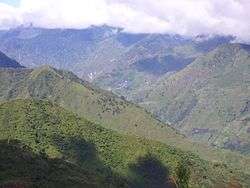Pasil, Kalinga
Pasil, officially the Municipality of Pasil is a 5th class municipality in the province of Kalinga, Philippines. According to the 2015 census, it has a population of 9,644 people.[3]
Pasil | |
|---|---|
| Municipality of Pasil | |
 | |
 Map of Kalinga with Pasil highlighted | |

| |
.svg.png) Pasil Location within the Philippines | |
| Coordinates: 17°23′N 121°09′E | |
| Country | |
| Region | Cordillera Administrative Region (CAR) |
| Province | Kalinga |
| District | Lone District |
| Barangays | 14 (see Barangays) |
| Government | |
| • Type | Sangguniang Bayan |
| • Mayor | Alfredo B. Malannag Jr. |
| • Vice Mayor | Theodoro A. Mosing |
| • Congressman | Allen Jesse C. Mangaoang |
| • Electorate | 6,916 voters (2019) |
| Area | |
| • Total | 189.00 km2 (72.97 sq mi) |
| Elevation | 669.9 m (2,197.8 ft) |
| Population (2015 census)[3] | |
| • Total | 9,644 |
| • Density | 51/km2 (130/sq mi) |
| • Households | 1,797 |
| Economy | |
| • Income class | 5th municipal income class |
| • Poverty incidence | 26.6% (2015)[4] |
| • Revenue (₱) | 62,181,547.37 (2016) |
| Time zone | UTC+8 (PST) |
| ZIP code | 3803 |
| PSGC | |
| IDD : area code | +63 (0)74 |
| Climate type | tropical rainforest climate |
| Native languages | Kalinga language Ilocano Tagalog |
| Website | www |
Barangays
Pasil is politically subdivided into 14 barangays.[5]
- Ableg
- Bagtayan
- Balatoc
- Balinciagao Norte
- Balanciagao Sur
- Cagaluan
- Colayo
- Dalupa
- Dangtalan
- Galdang (Casaloan)
- Guina-ang (Poblacion)
- Magsilay
- Malucsad
- Pugong
Climate
| Climate data for Pasil, Kalinga | |||||||||||||
|---|---|---|---|---|---|---|---|---|---|---|---|---|---|
| Month | Jan | Feb | Mar | Apr | May | Jun | Jul | Aug | Sep | Oct | Nov | Dec | Year |
| Average high °C (°F) | 21 (70) |
23 (73) |
24 (75) |
26 (79) |
26 (79) |
25 (77) |
24 (75) |
24 (75) |
24 (75) |
24 (75) |
23 (73) |
21 (70) |
24 (75) |
| Average low °C (°F) | 14 (57) |
15 (59) |
16 (61) |
17 (63) |
19 (66) |
19 (66) |
19 (66) |
19 (66) |
19 (66) |
17 (63) |
16 (61) |
15 (59) |
17 (63) |
| Average precipitation mm (inches) | 23 (0.9) |
28 (1.1) |
33 (1.3) |
64 (2.5) |
232 (9.1) |
242 (9.5) |
258 (10.2) |
266 (10.5) |
245 (9.6) |
201 (7.9) |
87 (3.4) |
69 (2.7) |
1,748 (68.7) |
| Average rainy days | 8.3 | 8.0 | 10.8 | 15.2 | 23.7 | 26.1 | 27.0 | 25.8 | 23.5 | 17.3 | 13.7 | 12.1 | 211.5 |
| Source: Meteoblue [6] | |||||||||||||
Demographics
| Population census of Pasil | ||
|---|---|---|
| Year | Pop. | ±% p.a. |
| 1970 | 5,557 | — |
| 1975 | 6,755 | +3.99% |
| 1980 | 6,872 | +0.34% |
| 1990 | 7,572 | +0.97% |
| 1995 | 8,935 | +3.15% |
| 2000 | 9,360 | +1.00% |
| 2007 | 10,084 | +1.03% |
| 2010 | 9,626 | −1.68% |
| 2015 | 9,644 | +0.04% |
| Source: Philippine Statistics Authority[3][7][8][9] | ||
In the 2015 census, the population of Pasil, Kalinga, was 9,644 people,[3] with a density of 51 inhabitants per square kilometre or 130 inhabitants per square mile.
Folkore
In an earlier time, Kabunian–the supreme deity of the Kalinga–left a drop of water upon an ancient tree he passed on one of his travels. This drop trickled down and with a great force akin to magnetism, attracted nearby brooks and rivulets to form what is now called the Pasil River.[10]
References
- "Municipality". Quezon City, Philippines: Department of the Interior and Local Government. Retrieved 31 May 2013.
- "Province: Kalinga". PSGC Interactive. Quezon City, Philippines: Philippine Statistics Authority. Retrieved 12 November 2016.
- Census of Population (2015). "Cordillera Administrative Region (CAR)". Total Population by Province, City, Municipality and Barangay. PSA. Retrieved 20 June 2016.
- "PSA releases the 2015 Municipal and City Level Poverty Estimates". Quezon City, Philippines. Retrieved 12 October 2019.
- "Pasil municipality". Philippine Standard Geographic Code Interactive. Retrieved on 2011-12-20.
- "Pasil: Average Temperatures and Rainfall". Meteoblue. Retrieved 8 March 2020.
- Census of Population and Housing (2010). "Cordillera Administrative Region (CAR)". Total Population by Province, City, Municipality and Barangay. NSO. Retrieved 29 June 2016.
- Censuses of Population (1903–2007). "Cordillera Administrative Region (CAR)". Table 1. Population Enumerated in Various Censuses by Province/Highly Urbanized City: 1903 to 2007. NSO.
- "Province of Kalinga". Municipality Population Data. Local Water Utilities Administration Research Division. Retrieved 17 December 2016.
- "Pasil Municipal Profile". NERBAC Cordillera Administrative Region. Retrieved on 2011-12-20.
External links
- Pasil Profile at PhilAtlas.com
- Pasil LGU Profile on the Local Governance Performance Management System
- Philippine Census Information
This article is issued from Wikipedia. The text is licensed under Creative Commons - Attribution - Sharealike. Additional terms may apply for the media files.